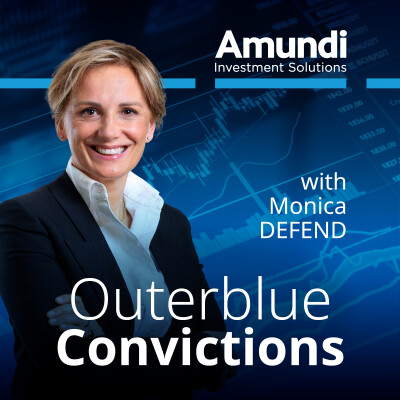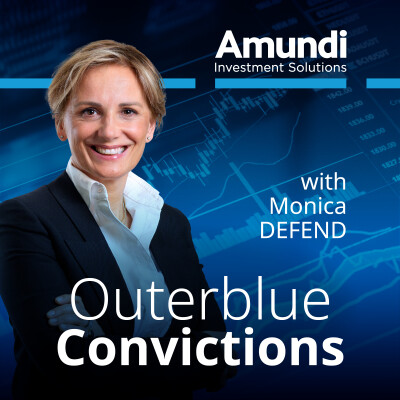- Disclaimer
This podcast is only for the attention of professional investors in the financial industry. Outerblue by Amundi. Welcome to Outerblue Convictions, Market Analysis and Asset Allocation Views.
- Swaha Pattanaik
Hello and welcome to this Amundi Convictions podcast where we discuss the what lies ahead for markets and economics. Today we have a really special edition for you today with Monica Defend, our usual guest star. Hello, Monica.
- Monica Defend
Thank you, Swaha.
- Swaha Pattanaik
And Monica, who's the head of the Investment Institute at Amundi, is going to be discussing what lies ahead for this next six months in light of the outlook that we've just produced. Monica, this was a really difficult exercise because the first six months have brought so many shocks, so many unexpected events. How has your view on the growth and monetary policy outlook for 2025 and beyond changed in light of all the shocks we've had so far?
- Monica Defend
Well, first of all, operationally, we had to work under scenario analysis framework given the fluidity of the decision-taking tariffs on, off, eventually, whether to define a baseline scenario. And according to that, we decided the growth patterns. So we do really see some slowdown in the economy and this is the baseline our take on tariffs, right? So lower growth, higher inflation and central banks that are in an uncomfortable position, in particular the Fed, because they have to cut rates, I mean slowing growth while managing inflationary pressures. So this is what is in our baseline so far. But then let's see how the situation on tariffs will evolve, because definitely this might change again and again.
- Swaha Pattanaik
So the tariffs were also designed by the U.S. administration to hit China particularly hard. How resilient has China proved and how are other EM economies coping with them?
- Monica Defend
I think that the strategy the U.S. administration has been conducting is the one of using tariffs to negotiate. And this was really the case with China. Eventually, by gaining really lower rates, at the same time, China has been quite resilient and has been leveraging on the policy support that is helping stabilizing the country. In general, in the emerging area, Asia is emerging as a clear winner. It is not only China that is lying on this rerouting of supply chain, but also India that is attracting multinational corporations and is leveraging on a nice and virtuous domestic dynamics.
- Swaha Pattanaik
Thank you. And the other thing that's helped emerging markets as well has been how the dollar's performance. Could you give us a little bit of the flavour of what you expect over the next six months for the US dollar, whose weakness has been helpful for EM so far?
- Monica Defend
Definitely. And not only for the emerging market, because also in the euro area, we enjoyed part of this weakness. In general, our call is for the US dollar to depreciate. The question is when these movements will turn from being cyclical into a structural one. And for this to materialize, we need really the Fed to be more dovish and being able to reduce the real rates. We maintain the view of the three cuts to come after the summer, so starting from September. The Fed will be data and policy dependent, but eventually, this would substantiate the case for a weaker dollar ahead.
- Swaha Pattanaik
Thank you. You were talking about cyclical versus structural, and the structural things you were mentioning were about the Fed, you know, some of those issues. Can I ask you something that's also even more structural, if you like, about how the dollar has been behaving relative to other asset classes? Usually, it would move in the opposite direction to stocks, but we've seen some of these correlations break down. What do you think is going on?
- Monica Defend
Well, I think that on the geo-economic, geo-political front, there are shifts that are taking place. And this is having an impact on the market dynamics, including correlations and volatility, safe haven demand. And the U.S. dollar really changed what is presumed to be a textbook behaviour at a time where we were seeing the US dollar not being the safe haven anymore, not being able to diversify the portfolio allocation, with the exception of the Middle East, because with what has been happening in the Middle East was more textbook behaviour with the US dollar taking some strength back. I think that the US- led framework is under question due to this new geopolitical order that is taking place. But to see a more material change, it will be a multi-year process.
- Swaha Pattanaik
Of course. No, absolutely, because it's been in place for so long. But as this multi-year process is sort of underway or taking place, it's very hard to make portfolios resilient in the same way and count on the same sort of correlations. What are you thinking of advising our clients, people in general, about how to make portfolios more robust in this environment?
- Monica Defend
Well, what we are doing is that probably we are more tactical than before, unless you have a very long-term conviction related to the energy transition, artificial intelligence, longevity, then all the rest might be more tactical. It is easier to start from sector allocation than top-down traditional macro allocation, given the macro uncertainty that is pending on the various countries. And moving into sectors, this allows you to identify winners and losers depending on the various risk source that you might have identified starting from tariffs. Having hedges in place is a good idea given the noise and volatility that we are experiencing, given also what is happening on the geopolitical front with the tension in the Middle East and the ones that are long lasting. So probably the traditional gold as a safe haven is something that might work. But we are looking at Europe, as it is very interesting, from domestic investors on the fixed income front, because in local currency it is more valuable than staying in Treasury, but also on the small and mid cap, there are some interesting opportunities, even going beyond the valuation case that still maintain a bit the appetite for this investment attitude.
- Swaha Pattanaik
Thank you. Well, you mentioned fixed income, so let me pick you up on that. This is the other thing that's been making life really hard in portfolio allocation because the long end of benchmark yield curves, which are supposed to be the safest havens, you know, in general, have been increasingly volatile and sensitive to fiscal sustainability issues. What's your view on where these really key important yields that matter for the economy as well as financial investors are heading next?
- Monica Defend
Well, if I think really that the risk premium on the yield curve is going to be structural, given the shifts that that we are seeing on trade, on the capital market, on demographics, it is something that is going to last. The volatility is really related to the sustainability and the fiscal credibility of a country. So the U.S. is under the spot, but we have seen mounting pressures also in Japan. And debt levels are high everywhere. So, t he risk premium will be there as well as volatility. It is very difficult to find a point or a target level of rates, which is something I'm personally not used to. We have quite broad ranges, so probably positioning along the curve might be more profitable than having an outright position on duration.
- Swaha Pattanaik
Great. Thank you, Monica. So you were telling us earlier about your approach to sectoral level equities, filtering, you know, how to pick winners and losers. Could you give us your overall view on stock markets in general? Because they've rebounded quite a lot from sort of the post-liberation day lows. They've been resilient in the face of a lot of geopolitical conflict as well. What lies ahead and how are valuations looking?
- Monica Defend
Starting from valuation, probably Europe and Japan are the most appealing countries. As I was saying, on mid-cap, industrials in Europe and domestic driven sector are really appealing. We like financial communication services relative to, for example, energy and materials. We use utilities as as a hedge, but there are some interesting thematics related to AI, defense infrastructure that are more long-term. But as I was saying, probably this is a time to stay in sectors rather than into regions. And it is not the time to be, it is the time to stay cautious because things might move, can move quite brutal. There is also a seasonal element that we might consider at this point in time. So hedges might be highly profitable.
- Swaha Pattanaik
Thank you, Monica. Thank you very much for joining us and also for that slightly more long range view, which will take us through a probably very hot summer.
- Monica Defend
Thank you.
- Swaha Pattanaik
So thank you for listening in and do check out the outlook that Monica and her team has put together, which is available on the Amundi Research Centre. We hope you will tune in again soon.
- Disclaimer
The podcast is only for the attention of professional investors as defined in Directive 2014-65-EU, dated 15 May 2014, as amended from time to time on markets and financial instruments, called MIFID II. Views are those of the author and not necessarily Amundi Asset Management SAS. They are subject to change and should not be relied upon as investment advice, as a security recommendation, or as an indication of trading for any Amundi products or any other security, fund units, or services. Past performance is not a guarantee or indicative of future results.






